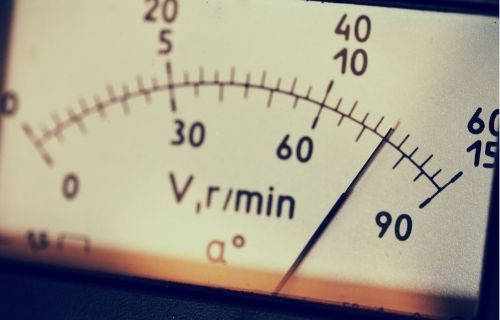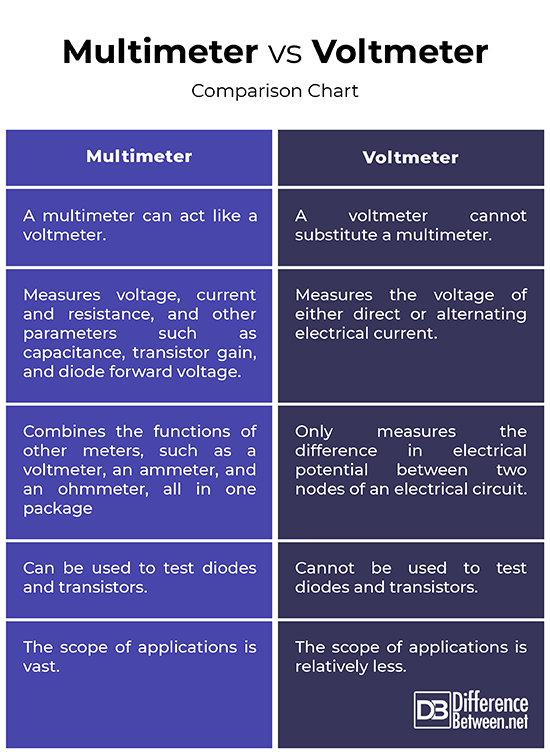Difference Between Multimeter and Voltmeter
You probably have a pretty vague idea about the difference between a multimeter and a voltmeter, but you’re not quite sure and you do not exactly understand how these two work. We look at these two instruments in detail and help you understand how the two differ. To better understand let’s get started.

What is a Voltmeter?
Voltmeter is an electrical instrument that is used to measure voltage of either direct or alternating electrical current in volts. It accurately measures the difference in electric potential between two points in a circuit. While some voltmeters are designed to work well with direct current, some voltmeters are better for measuring alternating current. And then there are some voltmeters that can read both. A voltmeter works on the same basic principle as an ammeter, except a voltmeter has a high resistance. It is designed in such a way that when connected in parallel to the circuit for measuring voltage it does not take appreciable current.
A voltmeter not only measures voltage but also current and resistance. A standard voltmeter used in the laboratories employs electromechanical mechanism for functioning and typically measures in the 1000 – 3000 volts range. A voltmeter measures voltage by passing current through a resistance. It is designed in such a way so as to offer minimum disturbance to the circuit. The voltage is represented using the letter ‘V’, and the sensitivity of a voltmeter is usually specified in ohms/volts.

What is a Multimeter?
If you notice a faulty appliance in your home and you are not sure what’s causing the fault, the best way to find out is to use a multimeter. A multimeter is a handheld instrument, more like electronics troubleshooting tool that you can use to diagnose the defective part of a circuit. A multimeter basically checks the electrical resistance within a circuit. In fact, it can be used to measure multiple electrical properties. A typical multimeter can measure voltage, current and resistance. More expensive versions can measure other parameters such as capacitance, transistor gain, and diode forward voltage.
A multimeter comes in two different types: an analog and a digital. A digital multimeter is like your digital wristwatch where the measured values are shown on a digital display, allowing you to read them easily with a relatively smaller chance of making an error. An analog multimeter, on the other hand, uses a needle along a scale to measure voltage, resistance, frequency, current, and signal power. Auto-ranging is yet another handy feature to look for in a multimeter if you’re willing to spend some extra bucks. This sets the test range automatically.
Difference between Multimeter and Voltmeter
Function
– A voltage meter or voltmeter is a handheld tool used to measure voltage of either direct or alternating electrical current in volts. It basically measures the difference in electrical potential between two nodes of an electrical circuit. A multimeter is essentially a multi-purpose troubleshooting tool that you can use to diagnose the defective part of a circuit. It mainly checks the electrical resistance within a circuit and combines the functions of other meters, such as a voltmeter, an ammeter, and an ohmmeter, all in one package.
Measurements
– A voltmeter not only measures voltage but also current and resistance. While some voltmeters are designed to work well with direct current, some voltmeters are better for measuring alternating current. A multimeter measures voltage, current and resistance. More advanced versions (or the expensive ones) can also measure other parameters such as capacitance, transistor gain, and diode forward voltage.
Applications
– A voltmeter can be used for the following purposes: voltage sensing, voltage measurement, electrical testing, laboratory testing, and electronic industry. A multimeter is a multi-purpose instrument that assumes the functions of other meters such as voltmeters, ammeters, and ohmmeters. The main applications of a multimeter include AC/DC current measurement, AC/DC voltage measurement, capacitance measurement, frequency measurement, battery testing, temperature and environmental applications, diode checking, and so on.
Multimeter vs. Voltmeter: Comparison Chart

Summary
In a nutshell, a voltmeter is a simple testing tool that is used to measure the difference in electric potential between two points in a circuit. A voltmeter works on the same basic principle as an ammeter, except a voltmeter has a high resistance. A multimeter, on the other hand, is a multipurpose troubleshooting tool that can be used to test the defective part of a circuit. A multimeter basically checks the electrical resistance within a circuit. In fact, it can be used to measure multiple electrical properties and can assume the functions of different meters, such as a voltmeter, an ammeter, and an ohmmeter.
Is a multimeter the same thing as a voltmeter?
A multimeter is a multipurpose tool that can assume functionalities of other meters, such as an ammeter, an ohmmeter, and a voltmeter. So, a multimeter can also act as a voltmeter. However, a voltmeter cannot be used as a multimeter substitute.
Can a multimeter be used as a voltmeter?
Yes, a multimeter can certainly be used as a voltmeter. In fact, it can be used to measure multiple electrical properties, including voltage, resistance and current.
Why does voltmeter or multimeter not give more accurate reading of voltage?
Most handheld digital multimeters or voltmeters are pretty accurate, but the standard ones are typically measured with±3% accuracy. The accuracy is affected by many factors though, including input impedance, temperature, and variations in the power supply voltage.
- Difference Between Caucus and Primary - June 18, 2024
- Difference Between PPO and POS - May 30, 2024
- Difference Between RFID and NFC - May 28, 2024
Search DifferenceBetween.net :
Leave a Response
References :
[0]Pickering, Martin. How to Use a Multimeter. North Carolina, United States: Lulu Press, 2016. Print
[1]Boysen, Earl and Nancy C. Muir. Electronics Projects For Dummies. New Jersey, United States: John Wiley & Sons, 2011. Print
[2]Shamieh, Cathleen. Electronics For Dummies. New Jersey, United States: John Wiley & Sons, 2015. Print
